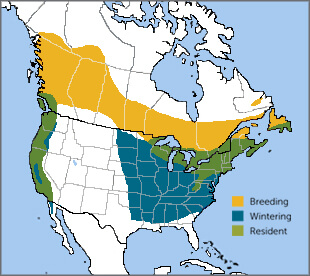
Purple Finch range map by NatureServe
Described by American ornithologist Roger Tory Peterson as "a finch dipped in raspberry juice," the male Purple Finch is a treat for any birder to see. Its genus name, Haemorhous, is slightly less appetizing, as “haemo” is Greek for blood, but it accurately describes the reddish-purple shades of this songbird and its North American relatives, the widespread House Finch and the Mountain West's Cassin's Finch.
The male Purple Finch is purplish-red on its head, upperparts, and breast. Its underparts are light with blurry red streaks, and the rump shows another splash of raspberry red. The female Purple Finch has streaky brown-and-white plumage and a strong facial pattern, with none of the bright raspberry color of the male. This marked difference between the sexes' appearances, known as sexual dimorphism, is seen in many other bird species including the Black-throated Blue Warbler and the Juan Fernández Firecrown, a rare hummingbird.
Boom-and-Bust Bird
Some years, including 2020, eastern birders note large numbers of Purple Finches moving into their areas. These movements, called "irruptions," are different from regular migrations and are likely triggered by a poor crop of conifer seeds, an important food source for the finches, in the north.
Other species prone to food-driven irruptions include the Pine Siskin and Evening Grosbeak. Some boreal-breeding raptors, such as the Northern Saw-whet and Snowy Owls, also range south in irregular, irruptive movements. These birds depend upon small mammals such as lemmings, which, like conifer cone supplies, also often follow boom-and-bust cycles.
Winter Wanderer, Sweet Singer
There are two Purple Finch subspecies, one found in the East and across much of Canada, and the other along the Pacific Coast region. The western subspecies is a bit less colorful and sings somewhat faster than its eastern counterpart. While the Purple Finch is a short-distance migrant, the subspecies show different migratory patterns: The western subspecies is an altitudinal migrant, similar to the Dark-eyed Junco and Western Tanager, while the eastern migrates in irruptive patterns as discussed above.
The Purple Finch sings a cheery-sounding series of slightly slurred whistles. Females have a similar song that can last one to two minutes; they often sing from the nest. In addition to their songs, Purple Finches also have calls that are shorter whistle-warbles, as well as a sharper “pik” note to sound alarm or to indicate position within a flying flock.
(Audio: Purple Finch song by Todd Wilson, XC97357. Accessible at www.xeno-canto.org/97357. Purple Finch call by Matt Wistrand, XC342339. Accessible at www.xeno-canto.org/342339)
Farmer's Friend
The Purple Finch has a strong conical bill similar to that of a Northern Cardinal. This big bill is a useful tool for splitting open seeds of maples, tulip trees, elms, sycamores, sweet gum, and many other species. It also crushes the bases of buds and flowers to extract nectar and feeds on small fruits, eating both seeds and pulp.
This latter feeding habit gave the Purple Finch an unjustified reputation as a species that damaged orchards and other crops. Closer examination of their feeding behavior reveals that Purple Finches don't harm crops, despite their consumption of small fruits and tree blossoms. In fact, they can be beneficial: They also eat crop-damaging cutworms as well as other caterpillars, plant lice, and plenty of weed seeds, particularly those of ragweed and burdock. Purple Finches often visit backyard feeders for sunflower and thistle seeds in winter, especially during irruption years.

Female Purple Finch © Michael Stubblefield
Finch Family Matters
Courtship between Purple Finches is more than a brief display. A male will “dance” in front of a female with a hopping performance, often balancing on one foot while holding a piece of grass, straw, or a small twig. With drooped, fluttering wings and a soft song, he will woo his prospective partner, pointing his bill up and making other moves that show off his color and prowess.
Once paired, the female assumes the bulk of the responsibility for nest-building, constructing her cup-shaped nest far out on an evergreen tree limb. The nest is built of twigs and rootlets, with finer grasses, moss, and animal fur lining the interior.
While the female alone develops a brood patch and incubates her eggs, her partner brings food to her on the nest. He plays a role in the chicks' lives as well, helping bring food to the hungry young once they hatch, while they're in the nest, and even for several weeks after they fledge.
Changing Range
Although the Purple Finch remains a widespread species, it has experienced gradual population declines. One of the main reasons seems to be habitat loss, which may be partly due to climate change. A close relative poses another threat: Originally a western species, the House Finch was introduced and is now also widespread in the East, where it often outcompetes the Purple Finch, particularly in urban and suburban areas. In some studies, this species dominates 95 percent of interactions with the Purple.
Human-dominated landscapes include other threats that affect the Purple Finch, from predation by outdoor cats to collisions with cars, wind turbines, and glass.
ABC is taking on these threats through a number of programs. Our Cats Indoors program advocates for responsible pet ownership, and we lead the way in providing solutions that reduce bird mortality at windows, wind turbines, communications towers, and powerlines.
Donate to support ABC's conservation mission!



















































